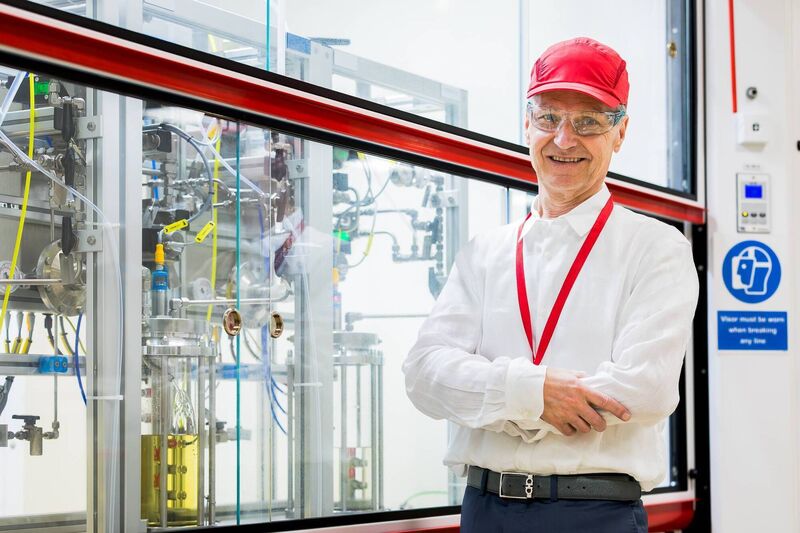Losing weight can be emotional, but the Cork plant making the active ingredient in weight-loss drug Mounjaro has no room for feelings — only precision.
Among the many detailed instructions given before passing through its heavy doors are no jewellery, make-up, or open-toe shoes.
No touching of machinery or straying from the path.
Definitely no mobile phones and not even a digital recorder could pierce the inner sanctum.
The 170 acre plant is busy with about 1,000 people on site at any one time.
How many tonnes or kilograms of the ingredient — tirzepatide — are produced here weekly?
This is where things became a little less precise — you could say opaque really.
It is maybe no surprise in the intensely competitive weight-loss market that pharmaceutical company Eli Lilly is as forthcoming on some details as Willy Wonka was about his chocolate formula.
Eli Lilly recently reported its revenue for the second quarter of this year jumped up by 38% to $15.56 bn (€13.2bn) driven by the surge of interest in Mounjaro and Zepbound (its brandname in the US).
Some of that manufacturing happens in this sprawling plant down narrow country roads outside Kinsale, Co Cork.
To be precise, in a new six-floor building.
It holds machinery which runs continuously over 24-hours to produce the ingredient for what is known as the King Kong of weight-loss drugs.
Instead of long noisy production lines and huge reactor vats, the company developed technology with a footprint a fraction of what you might expect.
A gleaming room holds tall — over 2m high — glass cabinets with metres of high tubing inside broken up by smaller machines and jars.
Some jars held gold-coloured liquid while another gleamed ruby-red under the bright lighting.
 Inside the plant in Kinsale.
Inside the plant in Kinsale.
They do not make Mounjaro in Kinsale, but what they make here is sent to another plant for further processing before it ends up in patients’ fridges.
Where is it sent? That is a good question.
General manager of Lilly Kinsale and senior vice president Tara Tibbs is on her second stint in Ireland from her home in Indiana.
Now in her 25th year working for the company, she is big on the family aspect of working for the firm, not so big on spilling family secrets.
Mounjaro works by activating two hormones — GIP and GLP-1.
These send messages to the brain that the stomach is full and stimulate the release of insulin after eating.
She said: “We make the peptide strand and we get it to its active ingredient — stable hold point — and then it actually goes somewhere else for final finishing.”
Just somewhere else in the global chain.
The final product is an injectable medicine for adults for treating diabetes and now also obesity.
Patrik Jonsson, executive vice president and president of Lilly International, is quick to point out other benefits studies have found.
Some of this research is funded by the company, some is independent.
A large-scale Washington University School of Medicine study this year showed lower risks of heart attack and stroke, a finding also reported elsewhere.
It also confirmed potential negatives including stomach conditions.
A key concern for many doctors is how little is known publicly about long-term effects of these new drugs.
Mr Jonsson does not agree, saying work on GLP-1s and gut hormones started “already during the 90s” at Eli Lilly with other diabetes drugs produced in the interim.
“So back to your question are we concerned about the long-term implications, we are actually not because this is a class of medicines that have been studied since the 1990s,” he said.
The site itself has been here for 45 years and its tentacles reach across Ireland.
Ms Tibbs points to links with Munster Technological University, University College Cork, and University College Dublin.
Its manufacturing site in Limerick has links with the University of Limerick.
 Tara Tibbs, senior vice president and general Manager of Lilly Kinsale.
Tara Tibbs, senior vice president and general Manager of Lilly Kinsale.
The Kinsale site is “uniquely placed”, she said, as they work with small molecule, peptide and big molecule platforms.
“We’ve transformed the site a few times,” she said.
The size of the plant in such a rural area gives it a feel somehow familiar to anyone aware of the history of The Big House in Ireland.
“I was here for Storm Ophelia, and we had power,” she said.
“We invited people in to the canteen at night. We had warm meals for the neighbours, let them charge their devices.”
She described a photograph she saw of local farmers bringing staff to work in tractors during the snow in 2018.
The site provides work too for caterers, security, scaffolding and many other firms who contract or supply labour and goods in.
Huge car-parks fill and empty, with free buses also taking workers to Cork or Bandon.
“We just recently added more routes because it had such a high up-take,” she said.
There is no popping out to the shops at lunch for sure.
Instead the company offers subsidised meals — set at €2 the day the Irish Examiner visited — and access to a gym, football pitch, and tennis courts.
Workers do not however get free or even discounted samples of Mounjaro, Jean Casey the director of corporate affairs was quick to point out.
There is a cost to all of this of course. Those giant profits come from people desperate to lose weight.
Mounjaro is only available in Ireland to private patients for now, on prescription.
It is under assessment by the HSE’s National Centre for Pharmacoeconomics separately for Type 2 diabetes patients and obesity.
Individual patients can pay €289 for the 2.5mg starting dose for one month, rising up close to €500 for higher doses.
Up to this week, some Irish patients ordered in from Northern Ireland as prices were lower there than across the EU.
Mr Jonsson was aware of this, saying they found UK product being used in many areas of the globe.
“The price in the UK was very different compared to the European average, there is no logic at all that prices in the UK should be significantly below the European average,” he argued.
“So that’s what we did, we adjusted the price in the UK and we also came to an agreement with the NHS that patients currently on treatment wouldn’t be impacted.”
It is no coincidence this followed hot on the heels of US president Donald Trump’s comments around the high prices of medicine in America compared to other countries.
 Patrik Jonsson, executive vice president and president of Lilly International.
Patrik Jonsson, executive vice president and president of Lilly International.
In February, Eli Lilly said it will build four new pharmaceutical manufacturing sites in America.
Driving around the Kinsale site or walking from building to building, it is hard to imagine this all packing up.
However, people with long memories will recall the same was said before the Ford plant closed in Cork in 1984.
Mr Jonsson does not appear to have any doubts about the plant’s future, and if he has he is not sharing.
Instead he insisted: “We are committed to Kinsale, our history here goes back a long way.
We’ve been investing heavily in Ireland over the last years and we are continuing to invest. So our commitment to Ireland is not a flash in the pan by any means.
He took in the Limerick site also saying: “All of our sites here will continue to pay a significant role in our supply chain for medicines today and also tomorrow.”
On the way out — after reclaiming phones and returning hard hats — the clang of machines drew attention to more construction on the site.
This area of Cork looks set to benefit from the weight-loss medicine boom for some time yet.
The European Medicines Agency (EMA) authorised Mounjaro for Europe to treat Type 2 diabetes and obesity.
It said the most common side-effects include nausea and diarrhoea, seen in more than a tenth of people. There was a similar percentage who experienced constipation and vomiting.
These symptoms were “generally mild or moderate” it said and more likely when people change doses.
People tend to start with a 2.5mg starter dose. That can be increased to 5mg, 7.5mg or 10mg.
Susie Birney of the Irish Coalition for People Living with Obesity welcomed the introduction of Mounjaro to Ireland last year.
However, she cautioned: “You have to choose the healthy options, it doesn’t work by itself. I think that’s the misconception, that it’s an easy quick fix for weight loss rather than actually treating a disease.”
There is also a financial risk for patients. Irish pharmacies show around €285 a month for the starter dose up to around €475 for 10mg doses.
The HSE is currently assessing Mounjaro for Type 2 diabetes and separately obesity.
“Both applications remain under consideration with the HSE. The HSE cannot make any comment on possible outcomes from the ongoing process,” it said on Friday.
It already reimburses patients for Saxenda.
Just this week too, the EMA warned of hundreds of false Facebook adverts selling illegal medicines. These were claimed to include tirzepatide, found in Mounjaro and semaglutide found in Ozempic.
Skinny jabs are targeting obesity in a way never seen before and the cultural implications of this are only just starting to become clear.
Seamstress Angie Smith makes wedding dresses. She is now seeing brides dropping multiple dress-sizes within weeks while taking these jabs.
“Some of them are losing their bum,” she told BBC Wales last week, describing stressful fittings and even re-designs.
It is likely few of those women would consider themselves obese.
The drugs were first expected to help people with serious health issues. They might have struggled with cabbage soup diets or diet groups.
People talk about losing “food noise” from their minds after starting the medication.
While doctors stress the injections also require lifestyle changes and warn of side-effects, patients are ready to take that chance.
Professor Donal O’Shea has said repeatedly the idea of “eat less, do more” is not suitable advice for people who are already obese.
Others are concerned about the wider cultural shifts.
Last month, the UK Advertising Standards Authority banned two adverts from Zara saying they featured models who appeared “unhealthily thin”.
Any woman who lived through the 1990s heroin-chic era when Kate Moss infamously said “nothing tastes as good as skinny feels” will have shuddered at that.
It is no exaggeration to say the body-positive movement which promotes larger sizes — sometimes also to extremes — is giving way again to the cult of thin as these drugs become more available.

